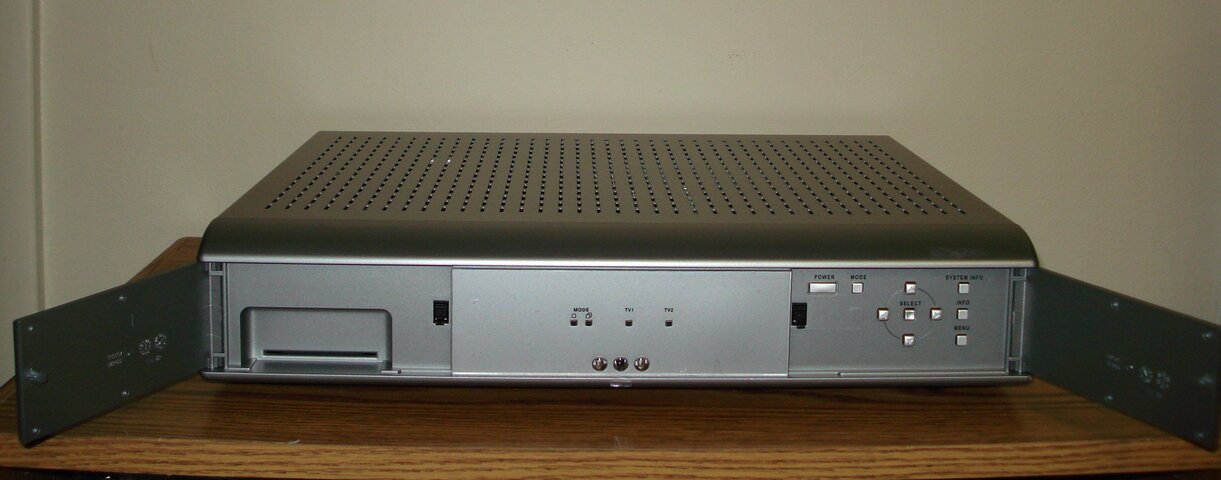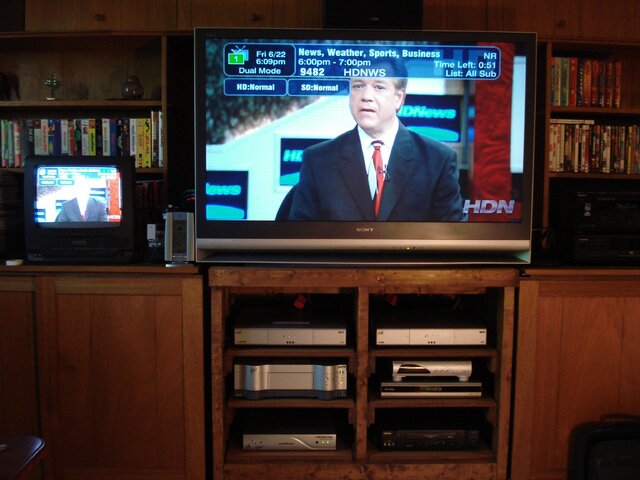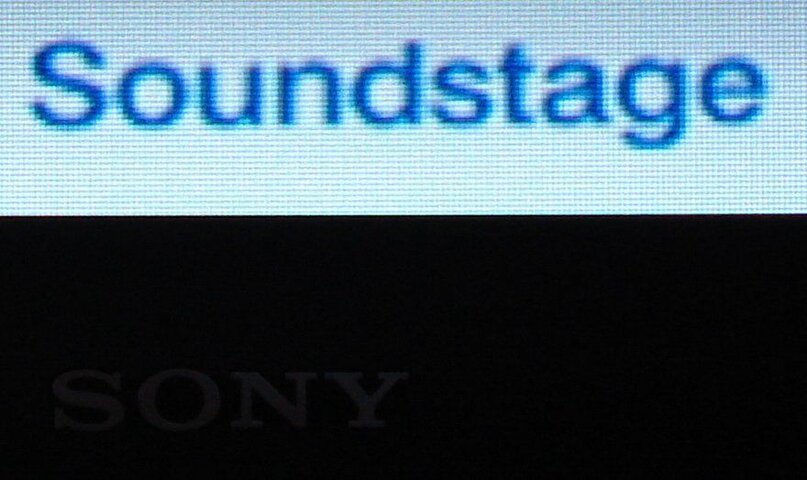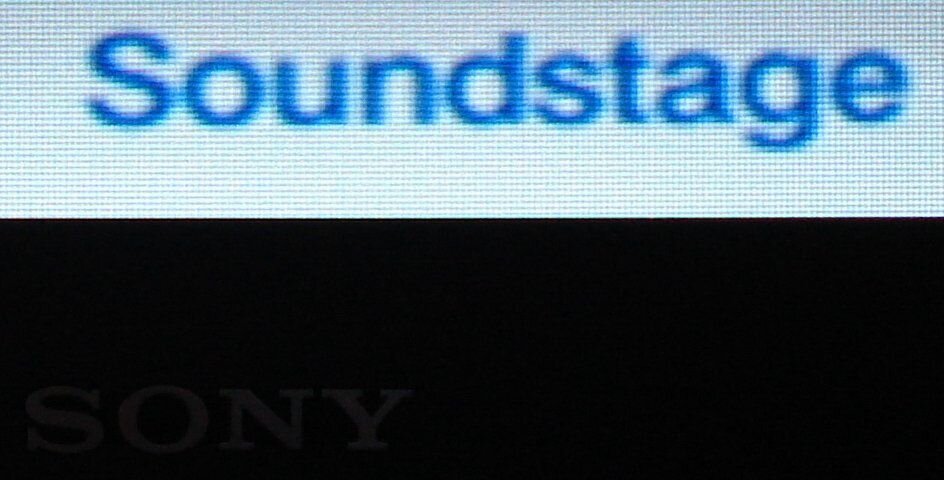Introduction to the ViP222
The ViP222 is Dish Network's most recently released receiver. Its two independent satellite tuners allow reception of Dish Network's SD and HD programming. The additional ATSC tuner allows reception of local digital off-the-air TV channels, in SD and HD. The receiver boasts a fairly complete selection of audio and video outputs for TV1, intended for a high definition TV located nearby.
A second set of connections for TV2 enables use of the 222 from a remote standard definition television. In dual mode, the TV1 and TV2 outputs are independent and function much like two separate single-tuner receivers. Single mode joins the two tuners for advanced functions such as picture-in-picture (PIP) and displays the same output on the TV1 and TV2 connections. The user interface is, for the most part, very similar to many other receiver models, including among others the ViP622 and 522.
The 222 at an Outer Glance, as Compared to the ViP622 HD DVR
On the outside, the 222 looks similar to my ViP622 HD DVR. However, the most striking difference is the presence of a heavily ventilated top cover on the 222, while the 622 has a solid top cover. The exterior front panel of the 622 has a record LED for TV1 and TV2, whereas the 222 does not (as it is not a DVR... at least as of now). Behind the left door is the access card slot on both receivers. Behind the right door, the 622 has a front panel USB port among its controls, while the 222 does not.
On the back panel, the two receivers are primarily the same. Some of the connections are in different places, but they both offer essentially the same collection of inputs and outputs. The only notable difference is that the 222 has an additional coax connection for TV1's output modulated to channel 3 or 4.
Images: (front) (back)
Functional Observations
I evaluated the operation of the 222 under version L3.01, the current version at the time of this writing. As a reference, my 622 has version L4.05, also current.
As stated above, the user interface of the 222 is practically identical to many other current receiver models. As a result, I will spare you the details of routine operation and of basic, uninteresting features and menu items.
Rather, the rest of this review will focus on personal observations in my use of the product over a week's worth of time. I'll try to keep the discussion points brief, to keep this review from becoming several miles long.
Modulators (Home Distribution on Ch. 3/4 or 21-69/73-125)
My home setup uses many modulators to distribute the output of my various devices to all of my televisions. The 222 has the most complete modulator output selections of any Dish Network dual tuner receiver that I have used.
Display Formats on HD and SD Outputs
The display resolution of the HD outputs can be configured, via the "HDTV Setup" screen (Menu - 6 - 8), to 480i, 480p, 720p, or 1080i. Additionally, the aspect ratio of the TV connected to these outputs can be set from this screen. The display format (zoom, stretch, bars, etc.) can be adjusted with one button press while watching TV.
One nice functional improvement over the 622 is that the TV1 HD and SD outputs have independent format settings. On the 622, you can press the * button to cycle through the formats. The HD and SD outputs are set to the same format when doing so (and the SD output's 4:3 aspect ratio is not taken into account). However, on the 222, pressing * changes the output format of only the HD connections. Pressing Page Up has the same effect. The Page Down key, on the other hand, changes the format of the SD outputs (when viewing HD content). Unlike the 622, the 222 is aware of the 4:3 aspect ratio on its SD outputs.
Images: simultaneous display of HD & SD outputs: (222) (622)
Picture Quality
To evaluate the 222's HD picture quality, and for comparison with the 622, I tested using component and HDMI inputs on my Sony KDF-E50A10 50" LCD HDTV. After connecting the 222 via HDMI and the 622 via component, I then swapped connections and compared the results. The 222 actually has a slightly sharper image than the 622 in both cases. As a result, HD programming on the 622 appears a bit softer.
The difference in sharpness was a little more noticeable in the displays generated locally by the receivers--namely the guide, menus, and other on-screen displays. The guide on the 622 looks somewhat fuzzy, while the 222 guide display is quite sharp. Again, this is true "across the board" with my TV, with each receiver connected via HDMI and connected via component. And the result is the same regardless of the resolution, 720p vs. 1080i.
Images: close-up of guide text (222) (622)
Brief Remarks on Additional Features
The observations discussed here I feel are noteworthy, but only warrant brief mention.
Comments From an Unbiased Third Party (aka. the TuxGirlfriend)
I asked my girlfriend, who has never really used any Dish Network equipment other than picking a channel to watch from the guide, to check out the 222 some and let me know her opinions. Here, briefly, are some of her findings (many of you shouldn't be too surprised by them).
Final Remarks
In just over one week of using the 222 I only ran into one issue that I would chalk up to a software bug (aside from the nonfunctional Caller ID mentioned above). At some point, the TV1 side became unresponsive. It was showing the channel it was tuned to, and the Menu button would lead to a black screen (pressing Menu again would return to programming). All other buttons did nothing, including power. A reboot solved this problem.
All in all, I have found the ViP222 receiver to be a good product. For me personally, the extensive modulator output capabilities, and independent display formats for the TV1 HD and SD outputs are nice bonus features. The picture quality is slightly better than that of the 622. A few features are lacking when compared to the 622, but for most people (myself included), they are of no great concern.
I was honored and excited to have won the 222 in the drawing, and I again thank this site (and Scott) and DishStore.net (and Claude) for it. I was especially impressed with the extremely fast delivery--I received it less than 1.5 days after the drawing.
Anything else I happen to notice while using it, I will be sure to add in this thread.
The ViP222 is Dish Network's most recently released receiver. Its two independent satellite tuners allow reception of Dish Network's SD and HD programming. The additional ATSC tuner allows reception of local digital off-the-air TV channels, in SD and HD. The receiver boasts a fairly complete selection of audio and video outputs for TV1, intended for a high definition TV located nearby.
A second set of connections for TV2 enables use of the 222 from a remote standard definition television. In dual mode, the TV1 and TV2 outputs are independent and function much like two separate single-tuner receivers. Single mode joins the two tuners for advanced functions such as picture-in-picture (PIP) and displays the same output on the TV1 and TV2 connections. The user interface is, for the most part, very similar to many other receiver models, including among others the ViP622 and 522.
The 222 at an Outer Glance, as Compared to the ViP622 HD DVR
On the outside, the 222 looks similar to my ViP622 HD DVR. However, the most striking difference is the presence of a heavily ventilated top cover on the 222, while the 622 has a solid top cover. The exterior front panel of the 622 has a record LED for TV1 and TV2, whereas the 222 does not (as it is not a DVR... at least as of now). Behind the left door is the access card slot on both receivers. Behind the right door, the 622 has a front panel USB port among its controls, while the 222 does not.
On the back panel, the two receivers are primarily the same. Some of the connections are in different places, but they both offer essentially the same collection of inputs and outputs. The only notable difference is that the 222 has an additional coax connection for TV1's output modulated to channel 3 or 4.
Images: (front) (back)
Functional Observations
I evaluated the operation of the 222 under version L3.01, the current version at the time of this writing. As a reference, my 622 has version L4.05, also current.
As stated above, the user interface of the 222 is practically identical to many other current receiver models. As a result, I will spare you the details of routine operation and of basic, uninteresting features and menu items.
Rather, the rest of this review will focus on personal observations in my use of the product over a week's worth of time. I'll try to keep the discussion points brief, to keep this review from becoming several miles long.
Modulators (Home Distribution on Ch. 3/4 or 21-69/73-125)
My home setup uses many modulators to distribute the output of my various devices to all of my televisions. The 222 has the most complete modulator output selections of any Dish Network dual tuner receiver that I have used.
- TV2 output is always available on the selected channel, UHF (21-69) or cable (73-125), via the "Home Distribution Ch 21-69 Out" connection.
- TV1 output is always available on either channel 3 or 4, via the corresponding "Ch 3-4 Out" connection.
- TV1 output can additionally be set to output on its own additional UHF or cable channel. This is not immediately evident in some product literature.
Display Formats on HD and SD Outputs
The display resolution of the HD outputs can be configured, via the "HDTV Setup" screen (Menu - 6 - 8), to 480i, 480p, 720p, or 1080i. Additionally, the aspect ratio of the TV connected to these outputs can be set from this screen. The display format (zoom, stretch, bars, etc.) can be adjusted with one button press while watching TV.
One nice functional improvement over the 622 is that the TV1 HD and SD outputs have independent format settings. On the 622, you can press the * button to cycle through the formats. The HD and SD outputs are set to the same format when doing so (and the SD output's 4:3 aspect ratio is not taken into account). However, on the 222, pressing * changes the output format of only the HD connections. Pressing Page Up has the same effect. The Page Down key, on the other hand, changes the format of the SD outputs (when viewing HD content). Unlike the 622, the 222 is aware of the 4:3 aspect ratio on its SD outputs.
Images: simultaneous display of HD & SD outputs: (222) (622)
Picture Quality
To evaluate the 222's HD picture quality, and for comparison with the 622, I tested using component and HDMI inputs on my Sony KDF-E50A10 50" LCD HDTV. After connecting the 222 via HDMI and the 622 via component, I then swapped connections and compared the results. The 222 actually has a slightly sharper image than the 622 in both cases. As a result, HD programming on the 622 appears a bit softer.
The difference in sharpness was a little more noticeable in the displays generated locally by the receivers--namely the guide, menus, and other on-screen displays. The guide on the 622 looks somewhat fuzzy, while the 222 guide display is quite sharp. Again, this is true "across the board" with my TV, with each receiver connected via HDMI and connected via component. And the result is the same regardless of the resolution, 720p vs. 1080i.
Images: close-up of guide text (222) (622)
Brief Remarks on Additional Features
The observations discussed here I feel are noteworthy, but only warrant brief mention.
- The Dish Home Interactive button does not prompt for confirmation. Prompting is useful if you accidentally bump the button since the application takes a while to load.
- The 622 and the 522 do have this feature.
- No picture-by-picture (a relatively new feature on the 622).
- Caller ID does not seem to work, even though the connection is reported as ok. The feature does work on my 622.
- The 222 does show the OTA digital sub-channel guide information.
- In the "Local Channels" screen (Menu - 6 - 9), the help screen states the following: "Local Channels can only be watched on TV1. Analog and Digital local channels are viewable with this receiver, but depending on local broadcasters, they may not always be available and not in all areas." However, the 222 does not actually seem to support analog local channels (I'm sure it's not referring to LiL, due to the TV1 reference).
Comments From an Unbiased Third Party (aka. the TuxGirlfriend)
I asked my girlfriend, who has never really used any Dish Network equipment other than picking a channel to watch from the guide, to check out the 222 some and let me know her opinions. Here, briefly, are some of her findings (many of you shouldn't be too surprised by them).
- She likes how it and the 622 are considerably smaller and quieter than my 921.
- The remote control is too cluttered. Having more colored buttons than the 921 remote is good though.
- The menus are also complicated. One of her examples here is how the "Caller ID History" screen is in the "System Setup" submenu (and I agree that it being in that submenu is a little strange).
- The default channel order in the guide is backward. I agree that most people would find that counter-intuitive and would expect the "list" of channels to be in ascending order as you move downward through it.
- She disagrees with me on the picture quality differences (sharpness/softness) between the 222 and 622.
Final Remarks
In just over one week of using the 222 I only ran into one issue that I would chalk up to a software bug (aside from the nonfunctional Caller ID mentioned above). At some point, the TV1 side became unresponsive. It was showing the channel it was tuned to, and the Menu button would lead to a black screen (pressing Menu again would return to programming). All other buttons did nothing, including power. A reboot solved this problem.
All in all, I have found the ViP222 receiver to be a good product. For me personally, the extensive modulator output capabilities, and independent display formats for the TV1 HD and SD outputs are nice bonus features. The picture quality is slightly better than that of the 622. A few features are lacking when compared to the 622, but for most people (myself included), they are of no great concern.
I was honored and excited to have won the 222 in the drawing, and I again thank this site (and Scott) and DishStore.net (and Claude) for it. I was especially impressed with the extremely fast delivery--I received it less than 1.5 days after the drawing.
Anything else I happen to notice while using it, I will be sure to add in this thread.
Attachments
Last edited:







